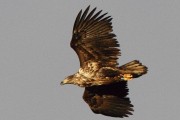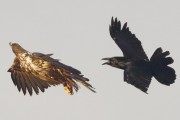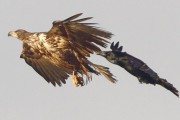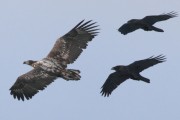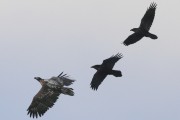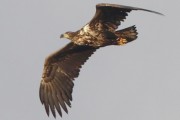An eagle in the isles – a Norwegian White-Tailed Eagle in Shetland
Posted by Brydon Thomason on Friday 11th January 2013 | Birding in Shetland
Once a well-established native Shetland breeding species, White-Tailed Eagle (also known as Sea Eagle) is now a very rare sight in the isles. Persecution and the rapid colonisation of Fulmars, led to the extinction of the Erne (which was the Shetland for the species), over 100 years ago. The last of the native Shetland population was shot in the North Mainland in 1917. This bird, an albino, was not only the last of the local birds but also the last individual remaining from the entire Scottish population.
Reintroduction programmes have now been running in Scotland successfully for many years in the west of Scotland, particularly in the Western Isles. Birds that have been bred in Norway are released in Scotland, all of which are tagged or colour rung for monitoring and tracking purposes. More recently birds reintroduced to NE Scotland have been fitted with transmitters so there movements can also be recorded.
On the 13th December 2012 I had just returned home from dropping our oldest son Casey off at nursery and was just about to do some work in our garden when my attention was drawn to the alarm calls of Greater-Black Backed Gulls nearby. Such distress from the local gulls usually only means one thing – large raptor! Looking out across the Voe in Baltasound I picked them up with the naked eye; five Greater-Black Backs mobbing a ridiculously large and broad winged bird of prey – “Sea Eagle”, I shouted to myself!
What a beautiful sight it was drifting in the voe over Baltasound on that calm and crisp frosty winter’s morning. It flew in the Voe being mobbed by local Greater-Black Backed Gulls and Hooded Crows, which were all dwarfed by its sheer bulk and 8ft wing span.
Again on Unst on Boxing Day it drifted north towards Saxa Vord, giving us a privileged view. What was very interesting about this individual was that on both sightings it appeared not to be ‘wing tagged’. This led me to suspect it might well be a genuine vagrant from northern Europe.
Most records of immature birds reaching Shetland tend to be (or are at least presumed to be) of reintroduced individuals from Scottish schemes, however after another fabulous sighting of the Unst bird up on Valla Field on Unst on New Year’s Day, my suspicions were confirmed when we were able to, not only be sure it lacked wing tags but more importantly (and by Robbie Brooks capturing these fantastic photographs) record the colour ring combination.
I was delighted when after emailing the images to various sources for confirmation on its origin, coordinator of the colour ringing project for Northern Europe, Dr Bjorn Helander of The Swedish Museum for Natural History, replied within an hour almost as excited as I was with confirmation that it was indeed a Norwegian bird of authentic origin. The colour combination also concluded it was rung as a chick in 2011 but without the actual ring numbers, specifics such as ringing locality could not be concluded. These colour combination were used on the entire Norwegian coast.
This confirmation sparked quite further excitement from ornithologists from Northern Europe working on White-Tailed Eagles as I also received a reply back from Alv Ottar Folkestad, leader of the Norwegian Sea-eagle Project (Norwegian Ornithological Society), who was also very excited by the sighting, stating that this was the first ever confirmed record they had of one of ‘their birds’ crossing the North Sea. In Shetland however there is at least one confirmed sighting of a bird baring a Norwegian colour ring on right leg, details of which I have since found for him. Alv also pointed out the bird’s apparent reduced/delayed moult which he stated was unusual and probably sugested poor physical condition over the past year.
Any sighting of such a magnificent bird as a White-Tailed Eagle is sure to be exhilarating regardless of its origin or locality, but from a birders perspective to prove it to be ‘the real deal’ and a genuine vagrant ‘Sea Eagle’ and not one that had been introduced, was very exciting indeed.
It is interesting to know that a bird from the Scottish reintroduction scheme that visited Shetland was actually found to be breeding back on the Norwegian coast. Thanks to the reintroduction programmes, White-Tailed eagle is once again becoming a common sight in certain parts of Scotland and with the on-going work and support of the RSPB and others they will hopefully continue to be so. With the more recent stage of the programme being in NE Scotland it is quite likely that we may well see this supreme bird of prey more often in the isles.
Update: since these sightings above, presumably the same individual was seen on the 10th January drifting south over Skaw on Whalsay.


